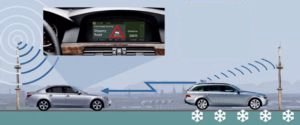 When it's not building neck-numbingly bad seats, or eye-wateringly ugly executive saloons, BMW is actually quite a clever company.
When it's not building neck-numbingly bad seats, or eye-wateringly ugly executive saloons, BMW is actually quite a clever company.
It's got next-generation telematics right. The best way to improve safety is to share up-to-the-second data about road conditions with the cars that are actually on the road. And the best way to do this without needing to violate the laws of physics is to adopt a peer-to-peer system, in which cars communicate directly with their neighbours, rather than going via a central control point.
Of course it helps to have a central co-ordinating point as well – partly to collate data and to send it to vehicles that are out of sight of other cars, but also to check whether the data from any particular car is trustworthy. This is how BMW's XFCD (Extended Floating Car Data) system seems to work:
A vehicle with XFCD which is stuck in a traffic jam and has been given the information over the radio can register that the information is correct, so it is not reported to the traffic centre again.”








